In a world where creativity knows no bounds, 3D printing is the superhero we’ve all been waiting for. Imagine crafting everything from intricate jewelry to life-saving medical devices—all from the comfort of your living room. It’s like having a magic wand that turns digital dreams into tangible reality. Who knew that a printer could do more than just spit out boring spreadsheets?
From revolutionizing the manufacturing industry to providing solutions in healthcare, the applications of 3D printing are as diverse as they are fascinating. Whether it’s creating custom prosthetics or building entire houses layer by layer, this technology is reshaping how we think about production and design. Buckle up as we explore the incredible ways 3D printing is changing the game and making the impossible possible.
Table of Contents
ToggleOverview of 3D Printing Applications
3D printing technology has gained traction across various sectors, creating innovative solutions and enhancing traditional processes. In manufacturing, companies utilize 3D printing for rapid prototyping, allowing them to design and test products efficiently. This capability reduces production time and minimizes costs.
Healthcare also benefits significantly from 3D printing. Personalized medical devices, such as custom prosthetics and dental implants, are tailored to individual patients, improving comfort and functionality. Surgeons often rely on 3D-printed models for complex procedures, enhancing surgical precision.
Architecture incorporates 3D printing to revolutionize construction methods. It enables architects to create intricate models quickly, aiding in visualization and design communication. Some firms have even experimented with 3D-printed homes, showcasing potential for affordable housing solutions.
The aerospace industry uses 3D printing to manufacture lightweight components, contributing to fuel efficiency and performance improvements. Engineers produce complex parts that traditional methods can’t achieve. Automotive manufacturers also leverage the technology for rapid prototyping of parts, streamlining the development process.
In addition, the education sector embraces 3D printing to assist in STEM learning, providing students hands-on experience with design and engineering concepts. Schools often integrate 3D printers in the curriculum, fostering creativity and critical thinking skills.
Overall, the versatility of 3D printing applications signifies its potential to transform industries. From custom products to efficient workflows, it drives innovation and shapes the future of production.
Medical Applications

3D printing significantly enhances various medical applications, transforming how healthcare professionals provide care. Innovations in this field continue to evolve, making treatments more accessible and personalized.
Prosthetics and Implants
Custom prosthetics are among the most impactful medical applications of 3D printing. This technology allows for the creation of tailored devices that match the unique anatomy of each patient. Patients experience improved comfort and functionality with these customized implants. Additionally, 3D printing enables rapid production, reducing wait times for those in dire need of prosthetic solutions. Companies reported that 3D-printed prosthetics can be produced at a fraction of the cost of traditional methods, making them more affordable. The ability to modify designs easily promotes continuous improvement in patient care.
Bioprinting Tissues and Organs
Bioprinting represents a groundbreaking approach in the field of regenerative medicine. Advances in 3D printing technology allow researchers to produce living tissues and organs using a combination of cells, growth factors, and biomaterials. By layering biological materials precisely, scientists create structures that mimic the complexity of natural organs. Potential applications include creating skin grafts for burn victims and developing organs for transplant. Studies indicate that bioprinted tissues could eventually reduce the organ transplant waiting list significantly. While this technology continues to develop, its implications for future healthcare solutions remain promising.
Industrial Applications
3D printing plays a crucial role in various industrial sectors, driving efficiency and innovation. Key applications include rapid prototyping and advanced manufacturing techniques.
Rapid Prototyping
Rapid prototyping enhances product development processes. It allows designers to convert ideas into physical models quickly. Increased speed in iterations enables teams to refine designs based on user feedback. Cost efficiency rises as companies minimize materials and labor during the prototyping phase. Industries such as automotive and aerospace benefit significantly from this technique, producing functional prototypes that serve for testing performance and aesthetics.
Manufacturing and Production
Manufacturing and production experiences a revolution through 3D printing technology. Reduced lead times lower the barriers to market entry, allowing companies to produce on-demand. Customization emerges as a vital advantage, enabling manufacturers to cater to specific customer needs without significant cost increases. Businesses benefit from decreased material waste, as additive manufacturing utilizes only the necessary amounts. This shift fosters sustainable practices within various industries, from consumer goods to industrial parts. The ability to produce complex geometries transforms traditional manufacturing, streamlining supply chains and enhancing product diversity.
Consumer Applications
3D printing has made strides in consumer applications, allowing individuals to create various products tailored to personal preferences. These innovations enhance creativity and accessibility for consumers.
Custom Products and Accessories
Custom products and accessories represent a significant segment in the consumer market. Personalized jewelry, eyewear, and phone cases exemplify how 3D printing empowers users to design unique items. Individuals can experiment with different materials and styles, resulting in products that express personal identity. This technology also reduces production costs, enabling affordable customization. Consumers appreciate the convenience of creating bespoke items from the comfort of home. Furthermore, small businesses leverage 3D printing to offer niche products, allowing them to compete effectively in the market.
Home Decor and Art
Home decor and art benefit greatly from 3D printing technology. Artists use this method for creating intricate sculptures, wall art, and decorative items that were once challenging to produce. Unique lighting fixtures crafted through 3D printing add a contemporary touch to living spaces. Customizable home accessories enable homeowners to reflect their style easily. Many people purchase 3D-printed home decor for its modern aesthetic and sustainability. Designers also explore innovative structural forms, pushing the boundaries of traditional home design. As a result, 3D printing revolutionizes how consumers approach interior aesthetics.
Educational Applications
3D printing greatly enhances educational experiences by providing innovative tools and resources for both teachers and students. This technology fosters creativity and improves engagement in various subjects.
Teaching and Learning Tools
Educators utilize 3D printing to create custom models for subjects like biology, physics, and history. These tactile resources help students grasp complex concepts by visualizing and interacting with their lessons. Many classrooms adopt 3D printers to develop hands-on projects, encouraging collaboration and teamwork among students. Projects can range from creating anatomical models to historical artifacts, making learning more relatable and exciting. With access to 3D printing technologies, instructors foster an environment that promotes curiosity while enhancing problem-solving skills.
Research and Development
Research initiatives benefit significantly from 3D printing, providing tools for experimentation and rapid prototyping. Students often engage in research projects that involve designing and testing prototypes, helping them apply theoretical knowledge to practical problems. Universities frequently support 3D printing facilities, allowing students and faculty to explore innovative ideas and develop solutions in various fields. Collaborative projects often emerge, bringing together students from different disciplines to focus on real-world challenges. As they operate these advanced technologies, they gain valuable experience that directly correlates to industry demands, preparing them for future careers.
3D printing stands at the forefront of innovation across various sectors. Its ability to create customized solutions is reshaping manufacturing and healthcare while enhancing educational experiences. This technology not only streamlines production but also fosters creativity and sustainability. As industries continue to explore its potential, the future of 3D printing looks promising. With ongoing advancements, it’s clear that this transformative technology will play a crucial role in shaping the way products are designed and produced. The possibilities are endless, paving the way for a more efficient and personalized world.





